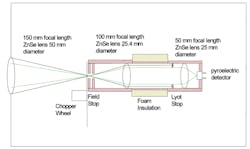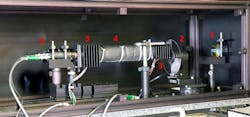Temperature is easy to measure approximately, but it’s often hard to measure with high accuracy, precision, and repeatability. It’s especially difficult to realize these objectives with the IR measurement approach, which uses a lens to focus the infrared radiation and a pyroelectric sensor to convert its heat energy into an electrical signal.
This non-contact method of gauging temperature by measuring the heat radiation given off by objects offers many advantages. However, there are also many error sources due to factors such as temperature differences along the thermometer and temperatures outside the instrument.
Researchers at the National Institute of Standards and Technology (NIST) developed a relatively compact (60 cm/24 inches long), portable IR thermometer—a class that’s formally called a thermal-infrared radiation thermometer (TIRT)—which overcomes these limitations (Fig. 1). It works over the −50⁰C (−58°F) to 150°C (302°F) range (corresponding to infrared wavelengths between 8 to 14 µm) and can measure temperatures with precision of a few thousandths of a degree Celsius.
1. As shown in the optical design arrangement of the ART, the ZnSe lenses and the temperature-stabilized compartment hold the tilted-field stop, aperture stop, lenses, and detectors. The entire assembly to the right of the chopper wheel is temperature stabilized at 23°C; the distance from the objective lens to the pyroelectric detector is about 55 cm. Note that the outer case of the ART isnm’t temperature stabilized. (Source: NIST)
That range is where most temperature activity of interest takes place, despite all of the efforts in both cryogenic and ultra-high ranges, said NIST physicist and project leader Howard Yoon. He pointed out “that 200-degree span covers nearly all naturally occurring temperatures on Earth. If you make a big impact in measuring objects in that range, it really matters.”
Applications for measuring with this class of accuracy and stability range from fairly routine non-contact diagnostics of mechanical equipment to a much more demanding use in measurements of sea-surface temperatures to validate remote-sensing weather- and climate-satellite sensors.
The complete NIST Ambient-Radiation Thermometer (ART) (Fig. 2) uses a set of internal thermometers to constantly gauge temperatures at different points in the instrument. Those readings are then used in feedback loop, which keeps the 30-cm (12-inch) core cylinder containing the detector assembly at a constant temperature of 23°C (72°F). The unit also includes additional focusing features to reduce errors due to IR radiation getting into the instrument from outside the targeted field of view (called a size-of-source effect).
2. In the NIST Ambient Radiation Thermometer, infrared light from a fixed-temperature calibrated source (at right, not shown) enters the thermometer enclosure through this lens, which focuses the radiation onto a “field stop,” analogous to the f-stop aperture in photography (1). A circular metal chopper slices the IR beam into a sequence of pulses (2). The first lens inside the central cylinder converts the light from the field stop to a parallel beam (3). The light passes through this insulated cylinder (about 30 cm long), which is temperature-controlled by a feedback system; stray radiation is blocked by another stop (4). A second lens focuses the light onto a pyroelectric detector (5). The detector output is routed to an amplifier that boosts the signal levels (6). (Source: NIST)
The detector assembly, which consists of a field stop, two lenses, the Lyot stop, and the detector itself, is critical to the low-noise, stable operation. (A Lyot stop is an optical “stop” that reduces the amount of flare caused by diffraction of other stops and baffles in optical systems.) The detector assembly, about 30 cm long, is on an anodized aluminum tube that’s temperature stabilized to 23°C via three independent thermoelectric (TE) coolers—one each for the sections with the field stop, the Lyot stop, and detector.
The temperature sensing of the two sections and the detector are performed using three separate glass-encapsulated thermistors, and commercial TE controllers are used to stabilize the assembly. The acquired radiation is modulated with a rotating chopper wheel (a similar technique is used in electronic-signal paths to avoid dc drift), and the modulated signals are measured using a commercial lock-in amplifier.
The temperatures of the assemblies are stable to better than 2 mK at their set temperatures. For optimal closed-loop performance, the temperatures are stabilized by letting all of the sections settle to the lab temperature. Then the setpoint is decreased to 500 Ω below the equilibrium thermistor resistance, corresponding to a setpoint that’s about 1°C higher than the laboratory temperature. Subsequently, the stabilization temperature is set to be just slightly above the lab temperatures to minimize convection effects.
The choice of the IR detector was critical, of course. Detectors that are sensitive to radiation in the 8- to 14-μm wavelength range include thermopiles, pyroelectrics, and bolometers, as well as quantum devices like HgCdTe detectors. Some detectors require cryogenic temperatures, but these were not selected, since the team wanted to develop a unit that could function over extended time periods without cryocooling.
Therefore, a custom high-gain, low-noise pyroelectric detector was developed working with a vendor. The detector’s requisite transimpedance (current-to-voltage) preamplifier, including a 100-GΩ feedback resistor, was integrated onto the detector as part of a single, sealed package.
Calibration, of course, is critical for an instrument such as this one. The complete radiation thermometer is calibrated using both variable-temperature water fluid-bath and an ammonia-based heat-pipe blackbody from −45 to 75°C. The standard temperature source for transferring that calibration to the ART involves a heat-source cavity inside about 42 liters (11 gallons) of liquid. The data is then adjusted with modified-Planck blackbody functions, with correction and compensation using advanced first-, second, and third-order error analysis. The table shows the estimated uncertainties in temperature measurement at 30°C.
Estimated uncertainties of the ART measured temperatures at 30°C (SPRT is a calibrated standard platinum resistance thermometer). (Source: NIST)
Details of the ART design, error analysis, and calibration procedure are in the paper “Improvements in the design of thermal-infrared radiation thermometers and sensors,” published in Optics Express from the Optical Society of America (which, in turn, has a link to a pdf version).
About the Author

Bill Schweber
Contributing Editor
Bill Schweber is an electronics engineer who has written three textbooks on electronic communications systems, as well as hundreds of technical articles, opinion columns, and product features. In past roles, he worked as a technical website manager for multiple topic-specific sites for EE Times, as well as both the Executive Editor and Analog Editor at EDN.
At Analog Devices Inc., Bill was in marketing communications (public relations). As a result, he has been on both sides of the technical PR function, presenting company products, stories, and messages to the media and also as the recipient of these.
Prior to the MarCom role at Analog, Bill was associate editor of their respected technical journal and worked in their product marketing and applications engineering groups. Before those roles, he was at Instron Corp., doing hands-on analog- and power-circuit design and systems integration for materials-testing machine controls.
Bill has an MSEE (Univ. of Mass) and BSEE (Columbia Univ.), is a Registered Professional Engineer, and holds an Advanced Class amateur radio license. He has also planned, written, and presented online courses on a variety of engineering topics, including MOSFET basics, ADC selection, and driving LEDs.




